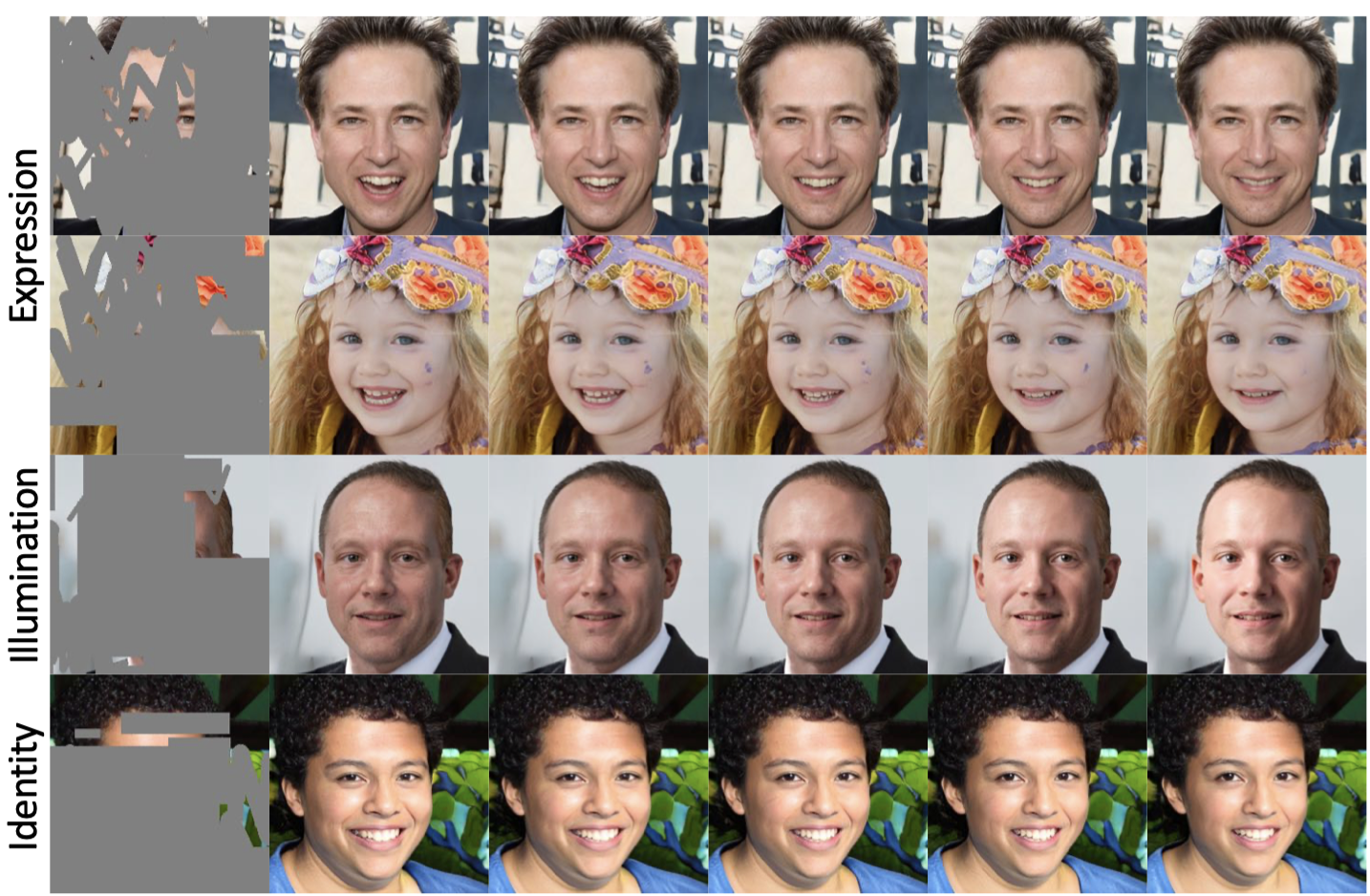Facial Image Inpainting with Semantic Control
In this repo, we provide a model for the controllable facial image inpainting task. This model enables users to intuitively edit their images by using parametric 3D faces.
The technology report is comming soon.
Quick Start
Installation
- Clone the repository and set up a conda environment with all dependencies as follows
git clone https://github.com/RenYurui/Controllable-Face-Inpainting.git --recursive
cd Controllable-Face-Inpainting
# 1. Create a conda virtual environment.
conda create -n cfi python=3.6
source activate cfi
conda install -c pytorch pytorch=1.7.1 torchvision cudatoolkit=10.2
# 2. install pytorch3d
conda install -c fvcore -c iopath -c conda-forge fvcore iopath
conda install -c bottler nvidiacub
git clone https://github.com/facebookresearch/pytorch3d.git
cd pytorch3d && pip install -e .
# 3. Install other dependencies
pip install -r requirements.txt
Download Prerequisite Models
- Follow Deep3DFaceRecon to prepare
./BFMfolder. Download01_MorphableModel.matand Expression BasisExp_Pca.bin. Put the obtained files into the./Deep3DFaceRecon_pytorch/BFMfloder. Then link the folder to the root path.
ln -s /PATH_TO_REPO_ROOT/Deep3DFaceRecon_pytorch/BFM /PATH_TO_REPO_ROOT
- Clone the Arcface repo
cd third_part
git clone https://github.com/deepinsight/insightface.git
cp -r ./insightface/recognition/arcface_torch/ ./
The Arcface is used to extract identity features for loss computation. Download the pre-trained model from Arcface using this link. By default, the resnet50 backbone (ms1mv3_arcface_r50_fp16) is used. Put the obtained weights into ./third_part/arcface_torch/ms1mv3_arcface_r50_fp16/backbone.pth
- Download the pretrained weights of our model from Google Driven. Save the obtained files into folder
./result.
Inference
We provide some example images. Please run the following code for inference
CUDA_VISIBLE_DEVICES=0 python -m torch.distributed.launch --nproc_per_node=1 --master_port 1234 demo.py \
--config ./config/facial_image_renderer_ffhq.yaml \
--name facial_image_renderer_ffhq \
--output_dir ./visi_result \
--input_dir ./examples/inputs \
--mask_dir ./examples/masks
Train the model from scratch
Dataset Preparation
- Download dataset. We use Celeba-HQ and FFHQ for training and inference. Please download the datasets (image format) and put them under .
/datasetfolder. - Obtain 3D faces by using Deep3DFaceRecon. Follow the Deep3DFaceRecon repo to download the trained weights. And save it as:
./Deep3DFaceRecon_pytorch/checkpoints/face_recon/epoch_20.pth
# 1. Extract keypoints from the face images for cropping.
cd scripts
# extracted keypoints from celeba
python extract_kp.py \
--data_root PATH_TO_CELEBA_ROOT \
--output_dir PATH_TO_KEYPOINTS \
--dataset celeba \
--device_ids 0,1 \
--workers 6
# 2. Extract 3DMM coefficients from the face images.
cd .. #repo root
# we provide some scripts for easy of use. However, one can use the original repo to extract the coefficients.
cp scripts/inference_options.py ./Deep3DFaceRecon_pytorch/options
cp scripts/face_recon.py ./Deep3DFaceRecon_pytorch
cp scripts/facerecon_inference_model.py ./Deep3DFaceRecon_pytorch/models
cp scripts/pytorch_3d.py ./Deep3DFaceRecon_pytorch/util
ln -s /PATH_TO_REPO_ROOT/third_part/arcface_torch /PATH_TO_REPO_ROOT/Deep3DFaceRecon_pytorch/models
cd Deep3DFaceRecon_pytorch
python face_recon.py \
--input_dir PATH_TO_CELEBA_ROOT \
--keypoint_dir PATH_TO_KEYPOINTS \
--output_dir PATH_TO_3DMM_COEFFICIENT \
--inference_batch_size 100 \
--name=face_recon \
--dataset_name celeba \
--epoch=20 \
--model facerecon_inference
# 3. Save images and the coefficients into a lmdb file.
cd .. #repo root
python prepare_data.py \
--root PATH_TO_CELEBA_ROOT \
--coeff_file PATH_TO_3DMM_COEFFICIENT \
--dataset celeba \
--out PATH_TO_CELEBA_LMDB_ROOT
Train The Model
# we first train the semantic_descriptor_recommender
CUDA_VISIBLE_DEVICES=0,1,2,3 python -m torch.distributed.launch --nproc_per_node=4 --master_port 1234 train.py \
--config ./config/semantic_descriptor_recommender_celeba.yaml \
--name semantic_descriptor_recommender_celeba
# Then, we trian the facial_image_renderer for image inpainting
CUDA_VISIBLE_DEVICES=0,1,2,3 python -m torch.distributed.launch --nproc_per_node=4 --master_port 1234 train.py \
--config ./config/facial_image_renderer_celeba.yaml \
--name facial_image_renderer_celeba

